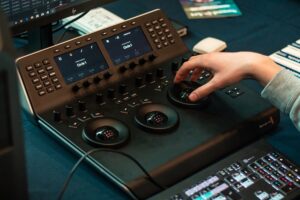Is it possible to Share Video Projects Between Screenflow And DaVinci Resolve?
Well the answer to the convert Screenflow to DaVinci Resolve projects is Yes & No. But likely yes in a way that is not what you’d hope for.
The Bad News Is:
While Screenflow and DaVinci Resolve are both great video editing software tools, they use totally different file formats and video project structures, so (at the time of writing) it is not possible to directly import a Screenflow project into DaVinci Resolve.
As you likely already know, you can export your Screenflow project as a video file, such as MP4 or MOV, and then import that file into DaVinci Resolve for adding effects and adjustments that are not readily available with Screenflow, so in that respect, all is not lost. You can also import older Screenflow produced videos for a facelift or editing.
 You Can Import Videos But Not Projects
You Can Import Videos But Not Projects
Once again I understand you likely know Screenshot well enough to to this already though for the sake of being thorough, let me explain
To do this, open your Screenflow project and select “Export” from the File menu. Choose the desired video format and quality settings, and save the file to your computer.
From the you can, open DaVinci Resolve, create a new project (or an exciting project), and import the Screenshot exported video file into your David project.
You can then edit and further refine the video in DaVinci Resolve.
It’s important to note that exporting your Screenflow project as a video file may result in a loss of quality, so it’s best to create a very high-quality expert video file to minimize any degradation. Just FYI, the free version of DaVinci Resolve is limited to a 1080p format.
While this seems a little “past it” in these days of 4k & 8k video. Online 1080p will still be a useful resolution for YouTube and most other video sharing sites, at least for the foreseeable future.
Additionally, if you used any special effects or transitions created in Screenflow may be difficult to recreate in DaVinci Resolve, though who really needs much more than dip to black anyway between clips anyway. Although if you haven’t tried DaVinci’s Fusion, its special effects weapon, you are in for a treat.
Good luck!
Common ScreenFlow & DaVinci Resolve Q&A’s
Q: What is the main difference between ScreenFlow and DaVinci Resolve?
A: ScreenFlow is primarily a screen recording and video editing software designed for creating screencasts, tutorials, and presentations, while DaVinci Resolve is a professional video editing software with advanced features for color grading, visual effects, and audio production.
Q: Are both ScreenFlow and DaVinci Resolve suitable for beginners?
A: ScreenFlow is more beginner-friendly, offering a straightforward interface and essential editing tools. DaVinci Resolve has a steeper learning curve due to its advanced features, but its free version provides a good starting point for learning the basics.
Q: Can I use ScreenFlow and DaVinci Resolve on both Windows and macOS?
A: ScreenFlow is only available for macOS, while DaVinci Resolve is available for Windows, macOS, and Linux.
Q: How much do ScreenFlow and DaVinci Resolve cost?
A: ScreenFlow offers a one-time purchase license, with prices starting at $129. DaVinci Resolve has a free version (DaVinci Resolve) and a paid version (DaVinci Resolve Studio) that costs $299.
Q: Can I record my screen with DaVinci Resolve?
A: DaVinci Resolve does not have built-in screen recording capabilities like ScreenFlow. You would need to use a separate screen recording software to capture your screen and then import the footage into DaVinci Resolve for editing.
Q: Can I edit 4K videos with ScreenFlow and DaVinci Resolve?
A: Yes, both ScreenFlow and DaVinci Resolve support editing 4K videos, though DaVinci Resolve is better equipped for handling higher-resolution footage with its advanced editing features.
Q: Does DaVinci Resolve support motion graphics and animations?
A: Yes, DaVinci Resolve has a powerful motion graphics and compositing tool called Fusion, which allows users to create complex animations and visual effects.
Q: Can I add captions and subtitles in ScreenFlow and DaVinci Resolve?
A: ScreenFlow offers built-in tools for adding captions, while DaVinci Resolve requires importing subtitle files or using third-party tools to create captions.
Q: Can I use LUTs (Look-Up Tables) in ScreenFlow and DaVinci Resolve?
A: LUTs are supported in DaVinci Resolve, which has advanced color grading capabilities. ScreenFlow has basic color correction tools, but it does not support LUTs.
Q: Can I edit audio in ScreenFlow and DaVinci Resolve?
A: Both ScreenFlow and DaVinci Resolve offer audio editing capabilities. ScreenFlow has basic audio editing tools, while DaVinci Resolve features a dedicated audio workspace called Fairlight for professional audio production.
Q: How do I export videos from ScreenFlow and DaVinci Resolve?
A: In ScreenFlow, you can export your project by selecting “File” > “Export,” while in DaVinci Resolve, you can use the “Deliver” workspace to set your output settings and render your video.
Q: Can I create proxies in ScreenFlow and DaVinci Resolve to improve editing performance?
A: DaVinci Resolve supports proxy workflows to improve performance while editing high-resolution footage. ScreenFlow does not have built-in proxy support but allows for changing the preview quality to improve playback performance during editing.
